 Lycoperdon - click to expand
Lycoperdon - click to expand
Latin for "wolf fart". Typically thought of as smaller species
<6 cm in diameter that form a pore at the top to let the spores
puff out. I will describe those species first.
Some species of Calvatia and all
species of Calbovista, Gastropila, Handkea and Vascellum that I
know of have sequenced inside of Lycoperdon so the this genus is now hard
to characterize. After the typical species, I will describe those that are
larger (6-15 cm across) and do not open up a pore to
release the spores. As those resemble Calvatia, check that section
too. Finally, some Calvatia that
haven't been sequenced yet no doubt still need to be moved to Lycoperdon.
It should be investigated if the Calvatia-like species that moved to
Lycoperdon are typically the ones where you can easily separate the outer and
inner skin (or that have a shiny interior skin). That does not seem to
always be the case, as L. vernimontanum n.p. does not have separable layers.
One final note: the typical and atypical Lycoperdon do not cluster
into two distinct clades, but seem to be somewhat mixed in the tree
together, which somewhat surprised me.
Species mentioned: Lycoperdon curtisii, marginatum,
pulcherrimum, pyriforme, perlatum, dermoxanthum, floccosum, molle, nettyanum,
nigrescens, foetidum, rimulatum, subincarnatum, umbrinum, subumbrinum,
vernimontanum n.p., excipuliforme, utriforme, bovista. Bovistella utriforme. Calbovista
subsculpta.
Calvatia bovista, sculpta, subcretacea. Gastropila fumosa, hesperia. Handkea. Vascellum
pratense, lloydianum.
Apioperdon pyriforme is described above and usually grows
on wood or buried wood, (unusual in Lycoperdon).
These white (when fresh) species are well decorated
with pyramidal warts and/or long spines whose tips often touch in
one stage of growth.
Lycoperdon curtisii NC/CT - This species is
supposedly round without a sterile base, with the smallest diameter (<2
cm) and has the smallest spores, 3-3.5u in diameter. It is often found in
pastures. There are 2 clades of sequences with this name with sequences from
ENA. One of them has identical ITS to Lycoperdon pratense, which may be
more decorated when young than we realize. A third clade only has sequences from
CA, far from the type area, so is likely not the real thing, but it may occur
here and I don't know what it is.
Lycoperdon marginatum EU - This
species has a sterile base-like stem area, and larger (<5 cm in
diameter) and has spores 3.5-4u in diameter. After the spines/warts shed, a
netted pattern is left on the inner skin, unlike the other two species. It
is often found in sandy soil. We have many EU sequences and do know what
this ITS sequence is. It has been found in ENA. So has a lookalike species with
distinct DNA and no known name yet.
Lycoperdon pulcherrimum PA - This
species also has a sterile base-like stem area, is also <5 cm in
diameter, and has the largest spores, 4-5u in diameter. It is found in
forests or clearings. We have one AZ sequence purporting to be this species,
but no reliable sequences.
No local DNA yet from any of these well decorated
species, but they all have been reported. We need collections.

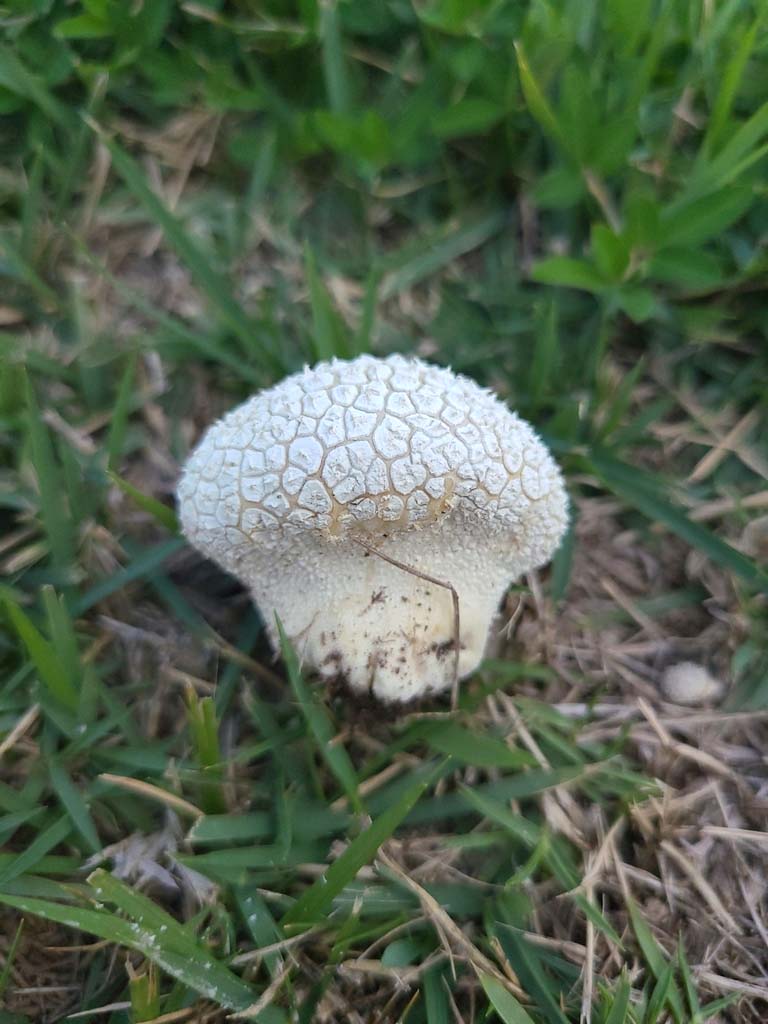
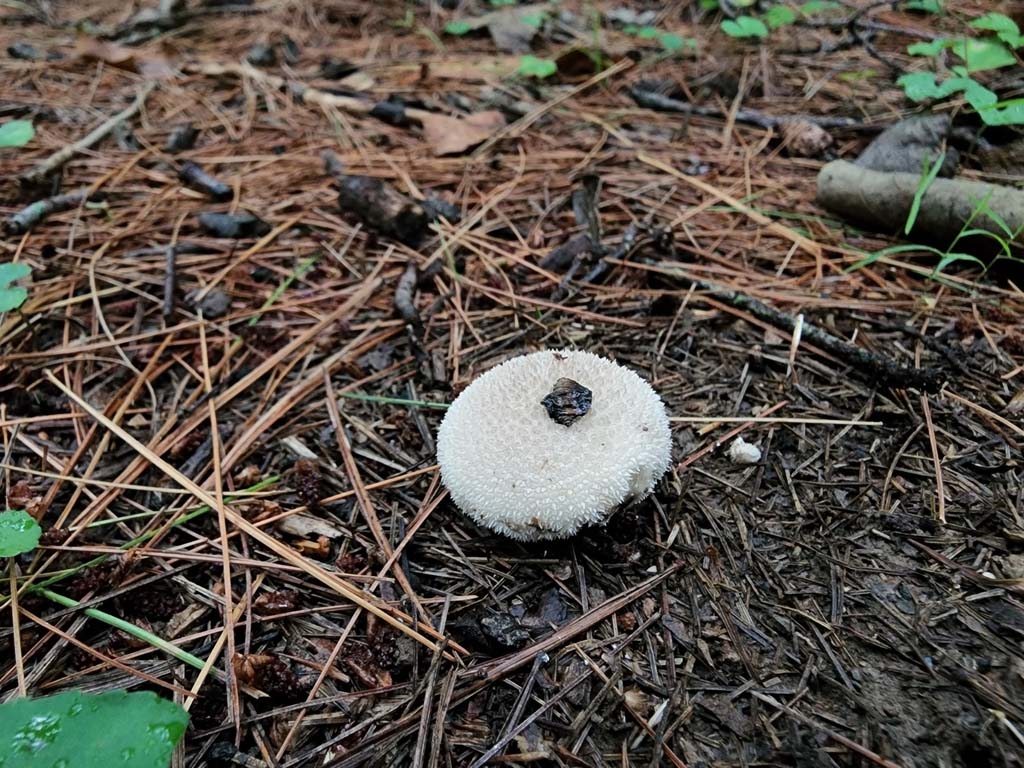
Three different species of well decorated puffballs from Indiana © Stephen
Russell
Lycoperdon pratense EU (=Vascellum pratense EU) - a white compressed sphere (flattened on top)
also <5 cm across found in grass. Much of the bottom half is
sterile and this can be noticed if it is cut in half. After maturity, a kind
of diaphragm separates the sterile part from the fertile part. The top
opens somewhat irregularly into a large hole, not as small and well-formed
as a pore. It shares ITS
with many ENA sequences of collections labeled L. curtisii that are
indeed highly decorated, but here L. pratense is mostly found without (or having lost)
its spines. We have many EU type area and worldwide sequences that match some of
our local collections.
'Vascellum'
lloydandium WA - differs by having the diaphragm visible only later in
maturity than in L. pratense, plus some microscopic differences. Jarvis'
master's thesis showed that it has distinct ITS (but those sequences were never
published). We need collections.
Lycoperdon
dermoxanthum EU - a similar small (1-2 cm in diameter), but almost
perfectly round puffball (unusual for Lycoperdon) also in grass or
waste soil that is white turning brownish in age. It is relatively
smooth but has well spaced fluffy, cottony warts that fall away to reveal lighter
brown scars on a darker brown background. There is no large sterile area
inside as there is in 'Vascellum'. This species is rarely identified
in the PNW, but DNA shows it is common, with many local sequences matching
Jeppson's official EU sequences, so we must have been mistaking it for 'Vascellum'
all these years.

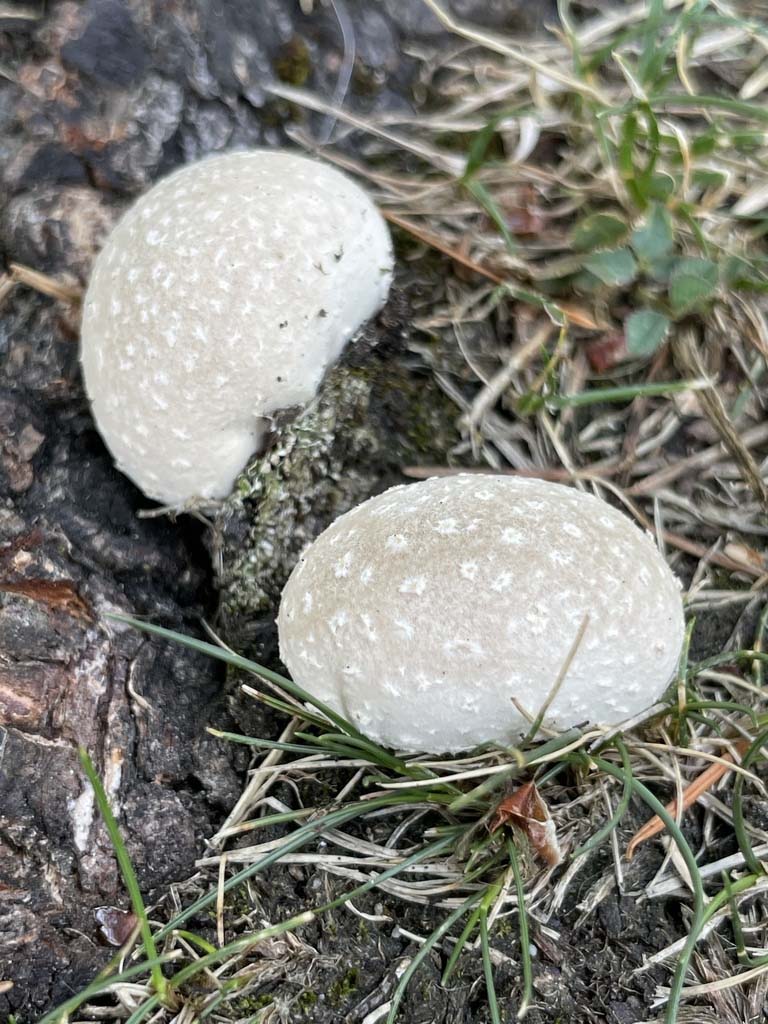
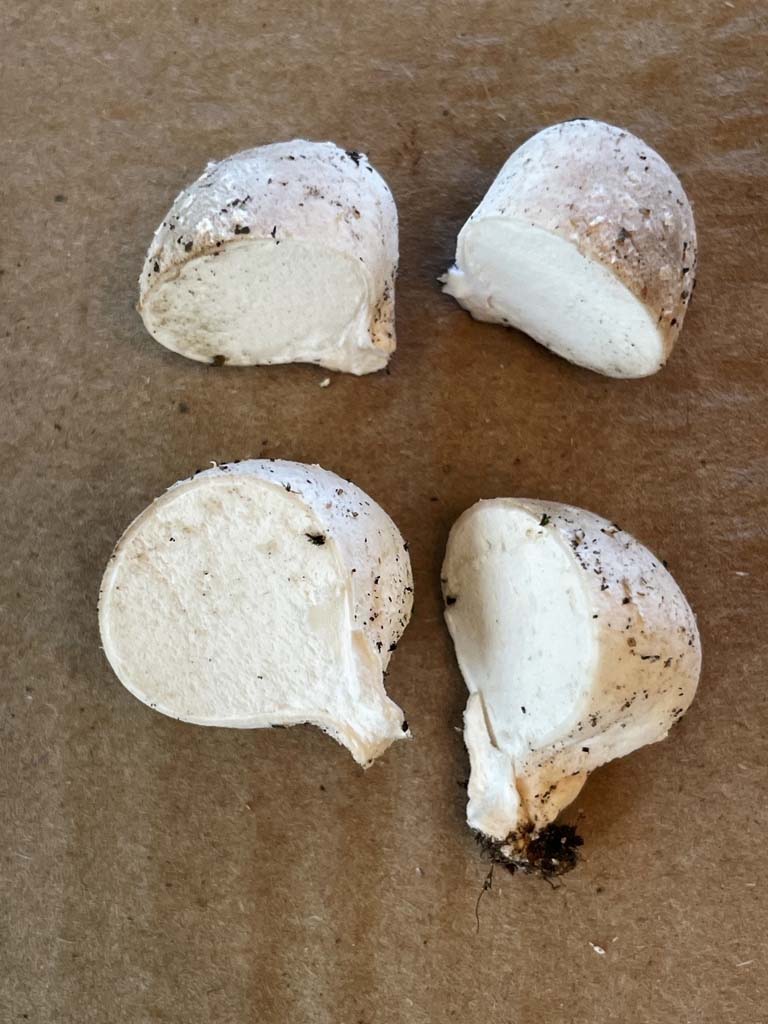


Lycoperdon pratense © Bitty Roy, Lycoperdon dermoxanthum ©
Yi-Min Wang (2 images), Bitty Roy, and NAMA and the Field Museum of Natural
History
Lycoperdon perlatum EU -
Easily recognized by its gem-like spines and large sterile base
(one of the largest in the genus). It is <6 cm across (but can be taller
due to the base). It starts out pure white but the spines and finally the
rest of the fruitbody can blacken in age. After a spine falls off, it
leaves behind a scar, as seen in the photo. A couple of EU type area
sequences are about 3 bp different than each other, and our own sequences vary
by about that much. Some are within 1 bp of an EU sequence, so this appears to
be a widespread species.
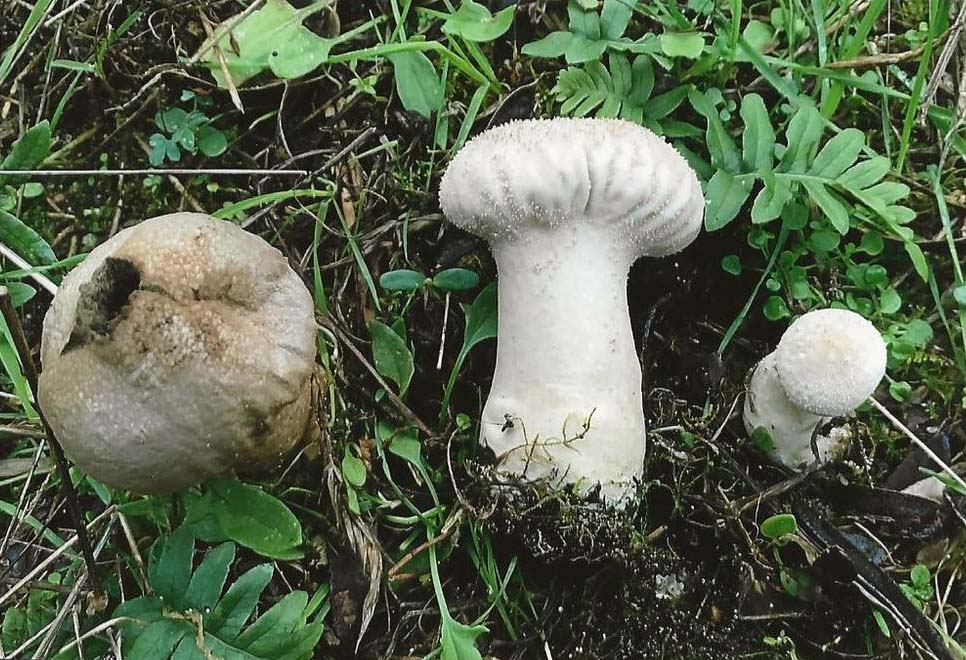
Lycoperdon perlatum © Buck McAdoo
Lycoperdon nigrescens EU (=Lycoperdon
foetidum EU) - significant, dark spines that leave a scar when
they wear away on a dark exterior, even when fresh. When young, the
colours are almost black. Almost round (<5 cm across). When
L. perlatum darkens in age it always has a large base. WA and BC sequences match EU sequences.
Lycoperdon umbrinum EU
(=Lycoperdon subumbrinum EU?) - eventually somewhat dark and spiny (but the spines aren't
as big as L. perlatum or L. nigrescens), although it starts out
white somewhat with cracked scales and without spines. The eventual spines are blackish on a yellow-brown exterior,
although the colours seem to be able to be dark or light. The powered
mature spore mass is usually olive-brown. The spines usually
don't leave a scar when they wear away, making a mature one appear to be
a smooth skinned species.
Jeppson described L. subumbrinum
because he had a bunch of sequences that were very different than his sequences
of L. umbrinum (not even in the same part of the tree). But his sequences
of L. umbrinum were mislabeled! They were actually 'Gastropila' fumosa.
I have no idea how that mistake was made. He acknowledged that the only
difference he could find was coarser ornamentation on the spores of L.
subumbrinum than in L. umbrinum. Since spore ornamentations measure
in tenths of a micron, to be coarser, we're talking a difference of only some
hundreths of a micron! That's no basis to describe a new species. That
should have been a clue that the two species he was looking at were not in
vastly different parts of the tree, but that the proper concept of L.
umbrinum was the one whose sequences were very, very close to his proposed
holotype of L. subumbrinum. His sequences
of the type collections of L. subumbrinum are indeed about 4 bp different
than actual sequences of L. umbrinum, but that species seems to have some
genetic variation as EU sequences of that species differ amongst themselves by
the same amount. And our local sequences differ by the same amount from
sequences of both species. I bet it's all one species, and that we have L.
umbrinum here in the PNW, and that L. subumbrinum is not a distinct
species.
Lycoperdon floccosum ENA - The exterior granules easily wear
away to make it appear smooth. There is a sterile base and many rhizomorphs on
the bottom. Smith considered it a
variety of L. umbrinum. There is one unsubstantiated report that it might
have been found here in 1980.
Lycoperdon molle
EU - similar to L. umbrinum but the background colour of the exterior
may not have yellow tones and the mature spore mass may be reddish brown
instead of olive brown. We have EU sequences to compare to, and CA sequences
that match well, but no PNW sequences yet of this
supposedly common species. We need some.
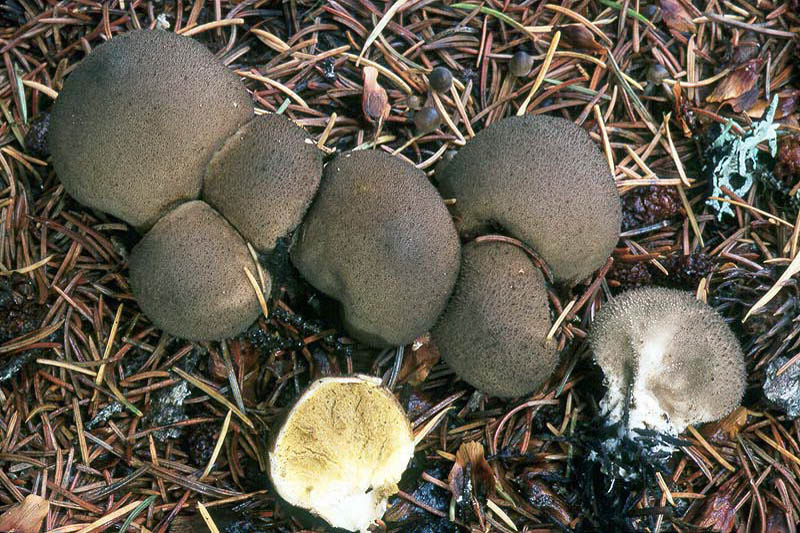
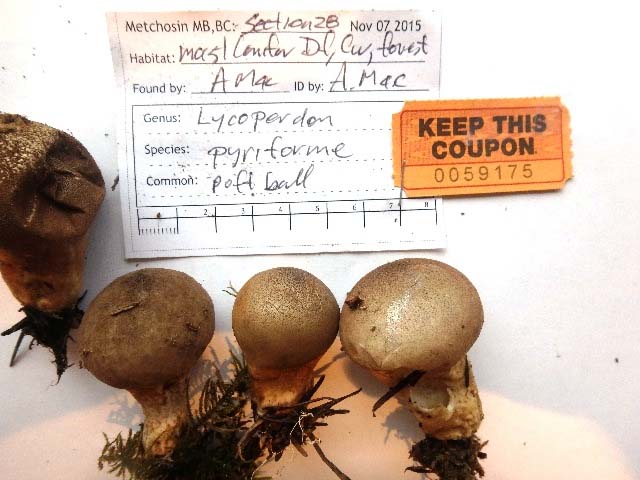
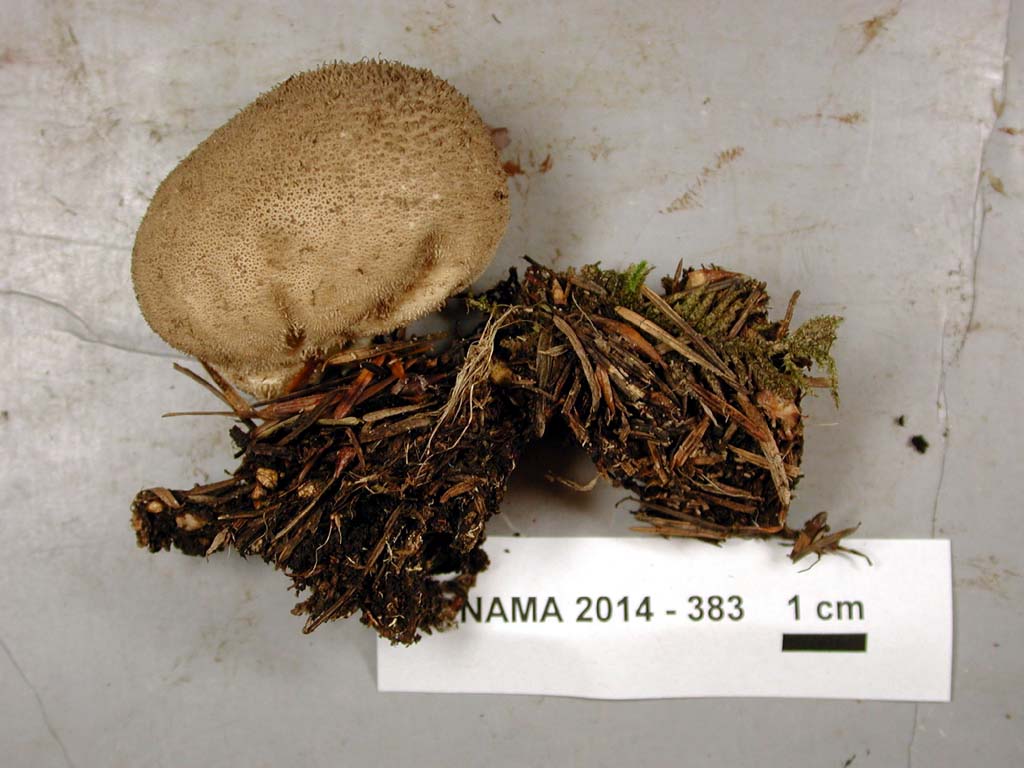
Lycoperdon nigrescens © Michael Beug (unsequenced), SVIMS (sequenced), and
NAMA and the Field Museum of Natural History (sequenced)


Lycoperdon umbrinum © NAMA and the Field Museum of Natural History, and
Shannon Adams
Lycoperdon nettyanum WA -
with a subtly spiny exterior at first, an obvious sterile base and
the exterior and interior layers of the skin separating easily. It is similar to Apioperdon pyriforme, reported once from WA. No DNA from
anywhere.
Lycoperdon rimulatum WI -
similar to L. nettyanum, but the exterior is even smoother. It was reported from OR. We have one possible sequence of this from AZ, but nothing
reliable and no local DNA yet.
Lycoperdon
subincarnatum NY - small and mostly round (<3 cm in
diameter), with dark spines on a pinkish tan background that
leave a scar after they fall off. The spore mass is purplish-brown
at maturity. Said to be found on hardwood, not on the ground. There are vague reports of this being in the PNW. We have
one NY type area sequence that might be this, but no local DNA yet.
Lycoperdon
vernimontanum n.p. WA (='Calvatia lycoperdoides' WA nom. illeg., =Handkea
lycoperdoides WA) - a round species (<5 cm in diameter) that
is white turning brown, delicately decorated with the exterior
somewhat cracking into warts. No sterile base. There already was a Calvatia lycoperdoides when
Smith described the one from WA, so that name was never legal. I haven't seen
sequences of this yet.
Lycoperdon excipuliforme EU (=Calvatia elata New England) - a brownish
puffball about 5 cm across on a substantial stem, but with a
relatively smooth exterior (unlike L. perlatum). The two
are generally regarded as synonyms, and sequences of L. excipuliforme
from the EU, ENA, Mexico and here in the PNW all match, so this appears to be a
worldwide species so the New England species probably is a synonym. We had only
vague rumours that it might be here, but then it was found and sequenced from
Victoria, BC.
Lycoperdon utriforme EU (=Bovistella utriforme EU, =Lycoperdon bovista EU, =Calvatia
bovista EU) - another
whitish puffball from 5 to 10 cm across with a somewhat thick skin
that is covered in irregularly shaped scales that form a mosaic and wear
off in age. It sits on a somewhat squat sterile base and is found in
grass and waste places. This should be looked for in the PNW as Calvatia tatrensis
EU is thought by some to be a synonym, and we need to figure out what local
variety
Calvatia tatrensis var. gruberi OR is. We do have many reliable sequences of L. utriforme to compare to, but
none from here.
Lycoperdon PNW01 - known
from WA, MT and WY. It has the same ITS2 as L. fumosum and one possible
concept of L. lambinonii EU, but differs in ITS1 from both. No data yet.
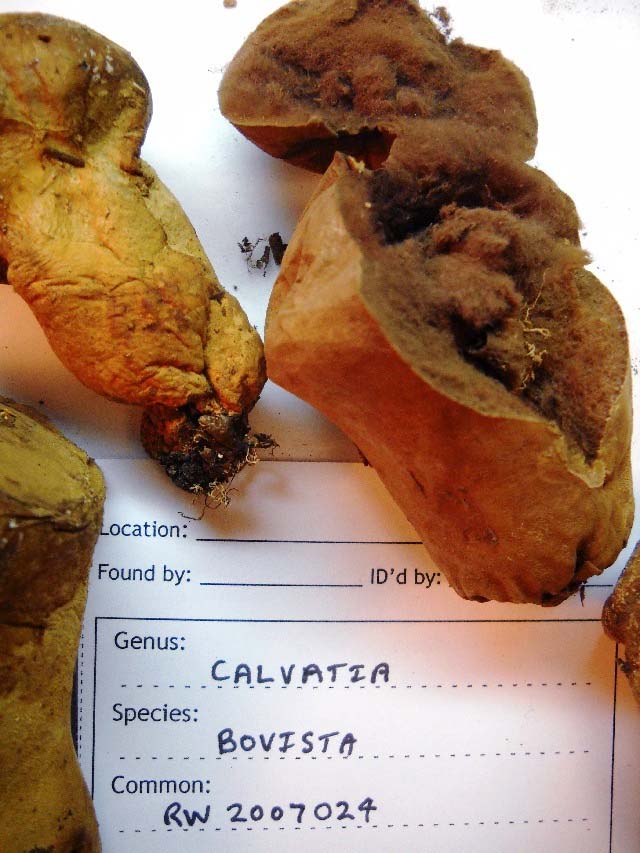

Lycoperdon excipuliforme © SVIMS, L. PNW01 © Yi-Min
Wang
Atypical Lycoperdon formerly/currently in other genera (usually
because they are large (>6 cm across) and don't form a pore)
'Gastropila' fumosa OR (=Handkea fumosa
OR) - a smooth, thick skinned round, whitish puffball, usually
3-8 cm in diameter, found in conifer forests. The skin may crack a bit
like dried mud. When mature, this puffball smells terrible, like a pit
toilet. It doesn't always open up much by itself, but the smell can attract
rodents to eat it and let the spores out. It needs to be renamed to
Lycoperdon fumosum. We have OR, ID, and CA sequences.
'Gastropila' hesperia CA - reported from ID in a more open place
than you would find G. fumosa, with harder to find ornamentation on the
spores. No word on how bad it smells. It probably needs to be renamed to
Lycoperdon hesperia. No DNA yet.
Lycoperdon sculptum CA (=Calvatia
sculpta CA) - The exterior warts on the very thick outer
skin are crazy looking. It is a large (8-15 cm across)
white puffball with a sterile base from high elevation conifer
forests. The skins cracks between the warts unevenly to expose the spores. We
have an OR sequence that probably represents this CA species.
'Calbovista' subsculpta CA -
A large white roundish puffball (6-16 cm in diameter) with
large, prominent pyramidal warts that make up a very thick outer layer.
It is from high elevation conifer forests. The skin cracks between the warts to
unevenly expose the spores. It needs to be renamed to Lycoperdon subsculptum.
We have an OR sequence that probably represents this CA species.
'Calbovista'
subsculpta var. fumosa ID - a variation with gray color, very
rudimentary squamule formation, and spores >5u diameter. We need a type sequence
as it is only known from the type collection. It probably needs to be moved to
Lycoperdon along with the type variety.
Lycoperdon subcretaceum EU (=Calvatia
subcretacea EU) - this round white puffball (2-5 cm in
diameter) has pyramidal warts with black tips and a very thick skin. The skin then breaks up
irregularly to expose the spores. Jeppson provides official sequences of this
species, and we have a matching WA and OR sequence.

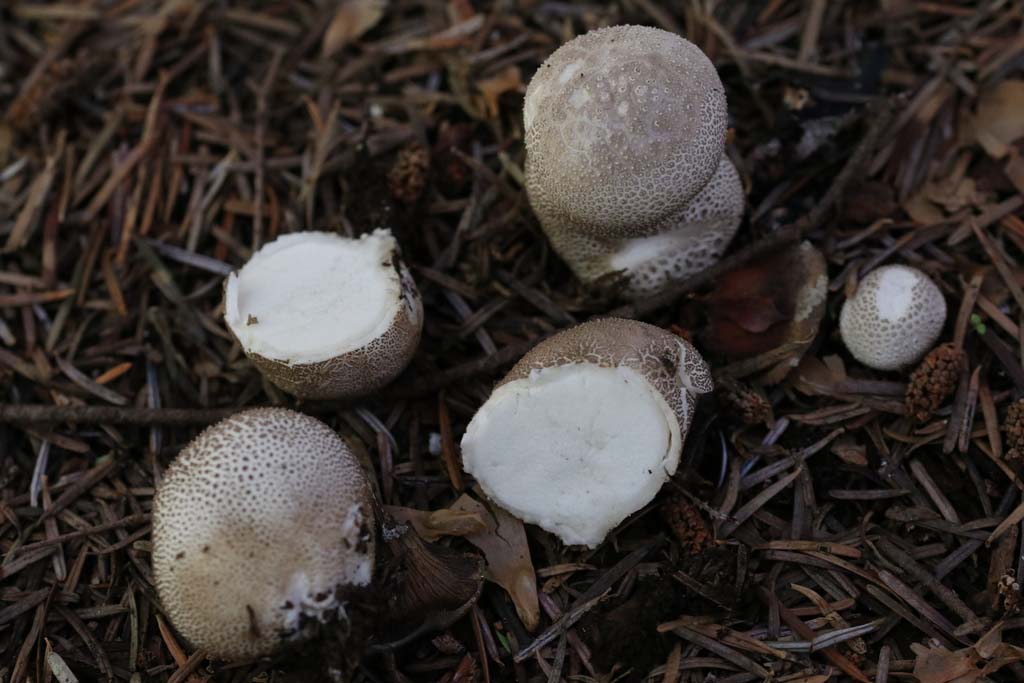
'Gastropila' fumosa © Andrew Parker, Lycoperdon
subcretaceum © Autumn Anglin
The "Poorly Understood"
Calvatia section contains more species that likely need to be moved to
Lycoperdon or that may be duplicates of other other species.
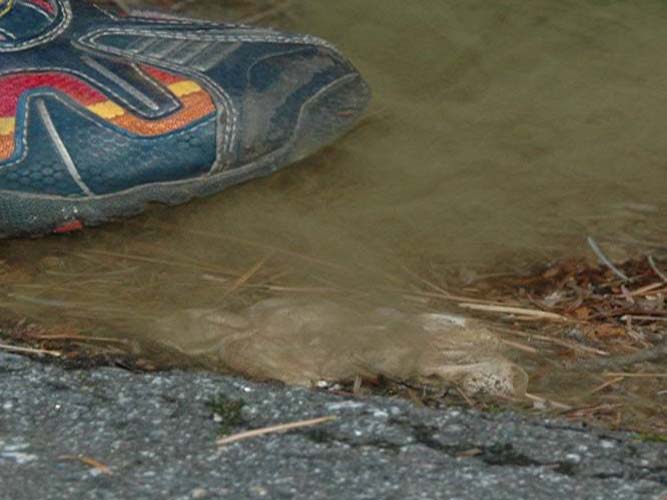
 Abstoma, Apioperdon, Bovista, Disciseda, Mycenastrum - click to expand
Abstoma, Apioperdon, Bovista, Disciseda, Mycenastrum - click to expand
 Calvatia - click to expand
Calvatia - click to expand
 Lycoperdon - click to expand
Lycoperdon - click to expand